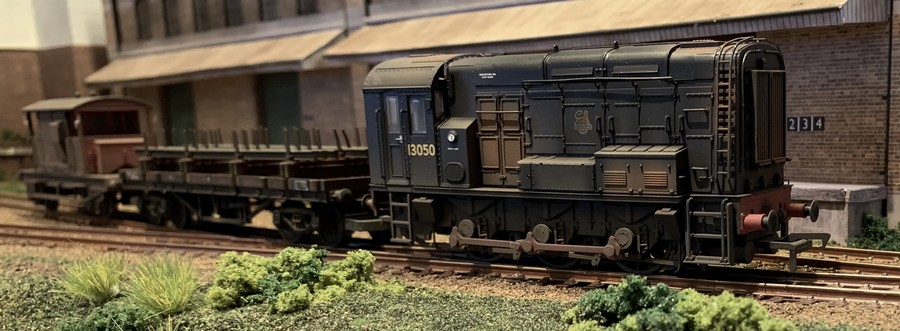 |
| |
 |
| |
"The lure
of the full-size railway is what in the first
place draws many people to the model railway
hobby. It is at this intangible level of the
emotions that the railway makes its strongest
appeal, although the technological and
historical aspects are undeniably full of
interest." (Terry Allen, Encyclopedia of
Model Railways, 1979)
There are many ways and
many channels through which the incentive spark
for railway modelling may catch on; here are some
sources of inspiration which had an impact on
Little Bazeley in specific and my railway
modelling in general.
|
|
| |
|
MODEL TRAINS
WITH A PURPOSE
|
|
| |
| I suspect that most railway
modellers were introduced to the hobby in much the same
way that I was: as a young child, with an oval of track
laid out on the living room floor, and a train whizzing
around, backwards and forwards. |
| |
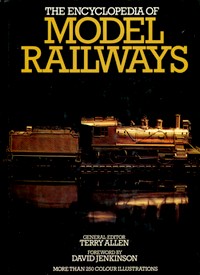 |
|
Even when I got back
into the hobby again, years later, I started out
with the typical "tracksets" which are
offered by many manufacturers as extensions to
their basic train sets. The result, invariably,
is a double track oval with some added sidings,
and it is basically still trains going round in
circles.
It
wasn't until I was given Terry Allen's
"Encyclopedia of Model Railways" (Octopus,
1979) as a gift that I realized that you could
actually run model trains with a purpose. It was
the first time I read about waybills and how
North American modellers ran freight trains in a
way that emulated the real thing. I also
discovered that an end-to-end layout could be a
consuming challenge if you actually followed
British railway signalling practice. And there
was more, from running your layout to a timetable
to actually coming up with your own integrated
transportation system.
It
was nothing short of a revelation, and I honestly
cannot say how many times I have read and perused
this book. It has been out of print for a long
time and has become rather outdated by now, but
even though I haven't thumbed through it in years
now, it totally changed my perspective on railway
modelling.
|
|
| |
| This was, of course, a typical
channel of the late 1980s and early 1990s, before the
advent of the internet and social media. Today, inspirational input on how to not
just model railways but do it in a way that provides
entertainment beyond "trainwatching" can be
found in enormous numbers and in generally high quality.
Websites, online videos, social media groups and many
more provide almost endless ideas and encouragement, and
no matter if you're a beginner or a seasoned modeller,
there's bound to be something out there that will
kickstart your creative thoughts.
|
| |
| |
|
|
| |
| Having perused the "Encyclopedia
of Model Railways" extensively and repeatedly, a number of attempts at putting this
changed perspective on model railways into actual layouts
were undertaken. However, they never really made it past
the partial building stage, and this was mostly if not
entirely due to the fact that I was trying to copy those
sprawling layouts the modelling press was championing. |
| |
| But
then another revelation happened - as I was
perusing one of said modelling periodicals. A
review in Model Railroader of a software
product called "RR Switch" caught my
interest. And since there weren't that many
railway-themed computer games around in 1990, I
ordered my copy from the author, Fred Miller, in
the States (snail mail was the only option back
then). The game proved to be utterly engrossing,
and I spent countless hours moving around virtual
cars in glorious 16
colour EGA on a computer running on DOS 3.1. The review had noted
that it was based on John Allen's Timesaver,
which didn't mean a thing to me at the time. But in playing the game it
slowly dawned on me that this would actually make
a cool small layout. Without even knowing it, I
had been bitten by the switching puzzle layout
bug.
|
|
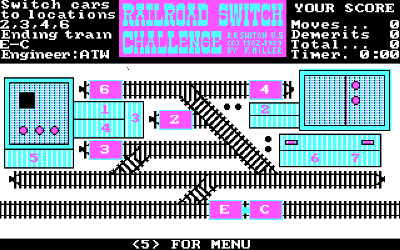 |
|
| |
| I did actually build an HO
layout taking the game as trackplan template, and it
provided lots of fun as the need for continuous running,
engrained by those early childhood memories, was taken
care of by a small Z Scale (1:220)
layout. |
| |
| By the mid-1990s the modelling
press as a whole was still, by and large, focussing on
huge and grandiose layouts on their glossy pages.
Alternatives only seemed to be offered by the gradually
emerging internet community, and one early and
influential example is Scot Osterweil's New York Centrall
RR Highland Terminal layout, which has been out there since
1994. A switching layout measuring 6'x1', it provided an
inspiring template for many other small layouts to
follow, and confirmed the shelf-style "small layout,
great fun" formula for me. |
| |
| |
|
THE INGLENOOK FORMULA
|
|
| |
| I was mostly
thinking up layouts in terms of Timesavers
and close clones until I chanced upon an article on Southampton Docks in the June 1998 issue of Railway
Modeller, showing how the general atmosphere
of such a railway setting could be incorporated
into modelling a small shunting layout. |
|
| |
| The first
of several track plans featured in the article
came with the suggestion to make the layout's
shunting moves more interesting, in spite of the
rather simple and straightforward arrangement of
tracks, by applying "the Inglenook
Sidings formula". |
|

|
|
| |
The article contained no more
information as to what this formula was and how it
worked; finding out in the late 1990s still very much
involved books as much as it did online research. The
results found through both channels were few, but I was
able to piece together that mysterious
"formula", in spite of Cyril J. Freezer, the doyen of
British model railway layout design, getting the
operational details wrong in his 1996 Model Railway
Design Manual (it should be five, not four wagons).
Otherwise, his description of the Inglenook Sidings
formula can't be faulted:
"Alan
Wright's Inglenook Sidings was deceptively simple,
just three sidings and a shunting neck. Operation was
made interesting by Alan selecting four wagons at
random using his "tiddlywink computer":
each of the distinctive wagons was allocated a token,
then all were placed in a cup and shaken before four
were taken out. These four wagons then had to be
assembled in the order drawn. This was rarely easy
and, on occasions, took a dozen or more train
movements to effect. It was the model railway
equivalent of Rubik's Cube."
To me, it seemed to
be the perfect distillation of having a small layout that
provided some meaningful and fun form of operation.
|
| |
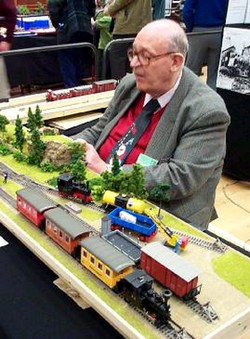
Alan Wright
(picture by Chris MacKenzie, used with kind
permission)
|
|
Wanting to know more about it, I
contacted Alan Wright in 2001, who was kind
enough to provide me with his personal
recollections on the Inglenook.
"In
December 1979, with the Manchester show
approaching, my colleagues at work asked what
I would be showing that year, and when I said
"nothing" I was taken to task, and
the next day one produced a blockboard
off-cut 4'0" by 1'0" and challenged
me to build a railway on it and show it.
Having some odd pieces of track and a couple
of points, Inglenook was born and the 5/3/3
formula was adopted.
It
was a roaring success at the show, I had the
small controller on a six feet long lead and
stood among the crowd listening to what they
had to say and then carried out the movements
they wished would happen. The aura of magic
such operation produced made the crowd wonder
if it was worked by someone watching on
television or was it a computer?"
The
inspiration gathered over a period of a good
fiteen years had finally come together, and in
2004 I designed and built Little Bazeley.
The concept
has quite obviously proven its worth to me: that
little Inglenook Sidings shunting puzzle layout
kept going for seventeen years, only to be
replaced by - Little Bazeley Mk 2.
|
|
| |
| Besides the actual layout
design and its operation, Little Bazeley can trace other
inspirational influences to a variety of sources; some
are directly related to railways, others less so. |
| |
| |
|
|
| |
| Little Bazeley is, of course, a
completely fictional location. And maybe this is just as
well, because if you were to board a train for Little
Bazeley, you should be advised that this quaint and
sleepy little place is also known as "the town of no
return". Not because so many holiday-makers have
decided to stay on and make it their home, but rather
because some strange disappearances have taken place of
late. That is the reason why you will find debonair John
Steed and dashing Mrs Emma Peel staying at the local pub,
the "Inebriated Gremlin" (the locals call it
the "Jolly Gremlin"). Afficionados of the 1960's cult TV series
"The Avengers" will no doubt recognise the name
of Little Bazeley as the seaside town that John Steed and
Emma Peel visited on their first assignment together,
introducing Diana Rigg to the series at the start of the
1965 season in the episode "The Town of no Return".
Steed:
"We'll have to hurry, the train leaves in less
than an hour. I'll explain the details to you on the
way down."
Mrs Peel: "And where are we
going?"
Steed: "Little Bazeley
by-the-Sea."
Mrs Peel: "Little Bazeley?"
Steed: "By-the-Sea."
Steed and Emma travel to the
place by train (steam hauled, actually), and as this is
one of my favourite "Avengers" episodes,
choosing the name of Little Bazeley is a somewhat
tongue-in-cheek little nod to the series for those in the
know. The only liberty I took is in moving the town from
East Anglia to the Sussex coast. A little cameo scene is
in the works - models of both Steed's trusted Bentley and
Mrs Peel's sporty Lotus are on hand, all I need now are
two appropriate figures to place on the layout...
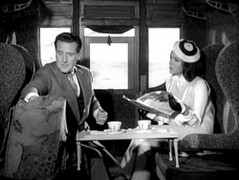 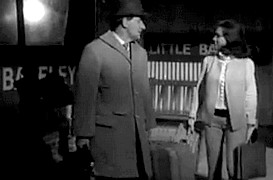 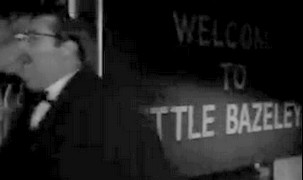
These images from
the opening minutes of The Avengers episode
"The Town of no Return"
are (c) StudioCanal Images SA, who have released superb
boxed sets of the entire series
|
| |
| |
|
|
|
| |
| Taken from a moving train (and
therefore of terribly poor quality), these two shots
caught 0-6-0 diesel shunters working the Battersea Park
sidings in September 1988 (the shunter in the right hand
picture easily identified as Class 09 012 Dick Hardy
due to its unique Intercity livery). They have made the
cut several times over the past decades, inspite of their
severe photographic defects, because they remind me of
the transition in my railway interests during the late
1980s, from (preserved) steam to everyday electric
multiple units and diesels (though I didn't see much of
those around South London lines). |
| |
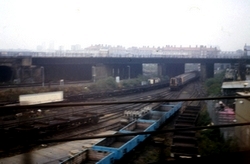
|
|
I did turn back to these
two slides when I started thinking about
an Inglenook Sidings layout, and the name
chosen for those armchair modelling ideas
was, indeed, "Battersea
Sidings".

|
|
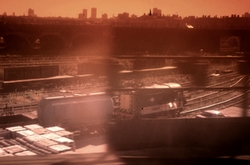
|
|
|
| |
| Quite a different type of
"prototype" is the imagined location of Little
Bazeley - the Sussex coast. |
| |

Littlehampton,
November 2021
|
|
One of my favourite
Sussex seaside spots (based on memories
both dating back to my childhood and more
recent times) is Littlehampton. The
London, Brighton & South Coast
Railway connected the town to the railway
network, but even Network SouthEast's
scaled down new station is too big an
affair to serve as template for Little
Bazeley.
|
|
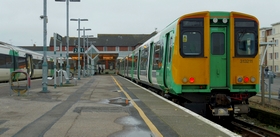
Littlehampton
Station (2015, Matt Buck)
|
|
|
| |
| So all I took from
Littlehampton as inspiration for Little Bazeley was the
waves lapping onto the beach - imagining that you can get
the same atmospheric soundtrack there. |
| |
| |
   
|
| |
|

Back to the Model
Railways Shunting Puzzles Website
main page
|
Page
created: 31/OCT/2021
Last revised: 25/SEP/2022
|
| |















